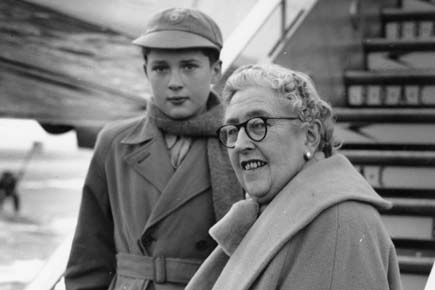How was Agatha Christie so good with her poison? Practice, says chemist and author Dr Kathryn Harkup, who spent considerable time studying the nurse-turned-crime novelist for a new book

Agatha Christie
ADVERTISEMENT
What made everyone's favourite crime novelist Agatha Christie so good with poisons?
Inside knowledge, Dr Kathryn Harkup will tell you. In her new book, A is for Arsenic (Bloomsbury Sigma), Dr Harkup, a chemist, says that before turning novelist, Christie worked at a dispensary at the local hospital in Torquay. For this, she had to pass examinations to qualify as an apothecary's assistant, or dispenser, which she did in 1917.

A picture from December 21, 1955, shows crime writer Agatha Christie. PIC/Getty Images
She was tutored in practical and theoretical aspects of chemistry and pharmacy by her colleagues at the dispensary. Dr Harkup even mentions how once Christie spotted a mistake in her tutor's concoction, making it potentially dangerous.
"Unable to confront the pharmacist with his mistake, and frightened of the consequences of dispensing the dangerous medicine, she pretended to trip and sent the suppositories crashing to the floor, where she trod on them firmly. After she had apologised profusely and cleared up the mess, a fresh batch was made, but this time at the correct dilution."

Dr Kathryn Harkup
In Dr Harkup's book, poison remains the protagonist, as she goes about detailing each chemical's dark past. If you haven't read all your Christie's just yet, breathe easy. The murderer still remains behind the curtain.
Edited excerpts from an interview with the author.
Q. What came first? The love for Agatha Christie or for chemicals?
A. Agatha, first. I remember reading her as a teenager and scouring the library shelves for any Hercule Poirot stories I might have missed on my previous visit. Chemistry came a few years later when I was deciding what I wanted to study at university. I had always enjoyed science at school but I liked the humanities too. Chemistry was the subject that made most sense to me and the more I studied it, the more I loved it.
Q. What prompted you to write a book like this?
A. The prompt came from the publisher. I received an email (out of the blue) asking whether I wanted to write a book. The publisher had been reading a blog I was writing about chemistry and invited me to submit ideas. It was an opportunity I couldn't turn down. I knew a book about poisons would be popular as it is one of the most popular talks I give as a science communicator, and if you are going to write about chemistry, you have to write about Agatha Christie, the Queen of Poisons.
Q. Studying poisons also makes for a morbid passion. Would you agree?
A. I suppose it is morbid but I don't see it that way. I am fascinated by how such tiny amounts of certain chemicals can have such devastating effects on the human body. Finding out why things go wrong can tell us an awful lot about how to make things right. Investigations into toxic substances can lead to research into medicines. Many things that are considered poisonous in high doses are extremely beneficial in appropriate amounts. It is the dose that makes the poison.
Q. What sort of research did the book require?
A. I have read a lot of popular science books on poisons that look into the history of these compounds. I have also consulted textbooks on toxicology and medicines as well as reading research papers into specific poisons, their uses, detection and antidotes.
Q. Any particular poison you find most interesting - either in the way it appears in the plot or its chemical make-up?
A. I am particularly interested in eserine, a poison extracted from the Calabar bean that grows in West Africa. It has an amazing history in terms of its use — locally as well as how it was brought into Western medicine via Scottish missionaries. In certain regions of Nigeria, the beans were once used to determine guilt in trials of criminals accused of serious crimes. An individual would be required to eat the beans and if they died, they were guilty. But if they survived, they were innocent. It seems incredible that this would have been an effective way of determining justice but there is quite a lot of science behind the whole story.
Q. There is a certain romance associated with poison. Would you say that where criminal fiction is concerned, writers take the easy way out with guns and stabbings?
A. I'm not sure that shooting or stabbing is the easy way out for a crime writer. Christie was always reluctant to use guns in her plots because she knew nothing about ballistics and felt she wouldn't appear credible. When she did have a shooting or a stabbing there is very little discussion of forensics. Poisons may seem like an easy way to have convenient symptoms and timelines for a plot but it is very easy to sound ridiculous or unbelievable when writing about them.
What I am impressed with is how much research many crime writers put in to getting their facts right and making their fictional worlds credible.
Q. It is said often that poison is a woman's weapon of choice. Is there evidence to support this?
A. There really isn't evidence to support it. Men are far more likely to kill than women and the majority of murderers use brute force, guns, knives or strangulation to kill. Most people lash out in the heat of an argument and use what weapons they have access to. Poisoning takes time and planning. Historically, women had more opportunity to use poison than men because they were the ones in charge of cooking meals but even then, women poisoners are very rare. The fact that a woman is accused of murder is more likely to get press attention.
Q. You have mentioned that Agatha Christie made up three poisons. Are they pure fiction?
A. The chemicals Christie invented are certainly feasible in terms of what she claims they can do. Christie's knowledge of drugs from her days of working as a dispenser of medicines gave her knowledge in the kind of symptoms that might be expected.
Q. What kind of research would Christie have put in to get the chemicals and their effects right?
A. Christie had a head-start when she trained as a dispenser. She had to know theoretical and practical chemistry as well as details of the different drugs she would be working with, how to mix them to produce pills, creams and tonics and which drugs should not be mixed together. Throughout her career she maintained a considerable library of medico-legal and toxicology books and was always keen to clarify details and learn more by writing to experts in the field.
(Excerpt from A is for Arsenic)
If Brenda were to make a mistake and inject eyedrops into me one day instead of insulin —I suspect I should give a big gasp, and go rather blue in the face and then die, because you see, my heart isn't very strong.
— Agatha Christie, Crooked House
In the quote above, Aristide Leonides is describing the details of his own death. He dies when he is injected with eserine eyedrops, which had been substituted for his regular dose of insulin. Eserine is an unusual choice of poison; Agatha Christie used it in only two of her novels, Crooked House and Curtain. You might expect a poisoner to have a detailed medical or pharmaceutical knowledge in order to choose eserine, but in Crooked House , Christie ensures there are plenty of suspects by giving Aristide a big audience when he speaks these prophetic words.
Aristide is actually answering a question from his granddaughter as she looks at his bottles of medicine — "Why does it say 'Eyedrops - not to be taken' on the bottle?" His extended family seated around him all hear his reply; one of them goes on to use the old man's own medicine to kill him.
The list of suspects in Crooked House is a long one: there is Aristide ' s second wife Brenda; his fi rst wife ' s sister, Edith; his sons, Philip and Roger; his sons ' wives, Magda and Clemency; and his three grandchildren, Josephine, Eustace and Sophia. There is also the household staff , including the cook, the tutor and the nanny; they all live together with the ' crooked man ' Aristide in his crooked house...
...When the culprit is finally revealed it still comes as a shocking revelation (Christie's publishers even had the nerve to ask her to change it, but she refused). The poison used, eserine, had come a long way to arrive in the Leonides household. This compound is an extract from the beans of a West African plant, Physostigma venenosum . Eserine has had a variety of applications in medicine, from the management of glaucoma to emergency treatment for nervegas poisoning.
— Excerpted with permission from A is for Arsenic by Kathryn Harkup, published by Bloomsbury
 Subscribe today by clicking the link and stay updated with the latest news!" Click here!
Subscribe today by clicking the link and stay updated with the latest news!" Click here!







